14 - Sons of Devils
from Part II - Character-Types
Published online by Cambridge University Press: 05 February 2013
Summary
The ultimate anti-type in medieval culture is, perhaps by definition, the figure of Antichrist, who owes his place in the Christian imagining of the events leading up to the end of the world precisely to the way in which he both impersonates and inverts Christ's role as the principal hero of the Gospels; and I shall argue in this essay that he is also therefore implicitly the ultimate prototype for all the various figures in medieval romance whose being or ancestry is specifically represented as demonic. In the version of events imagined in the treatise De ortu et tempore Antichristi attributed to Adso of Montier-en-Der (ca. 920–992), which was to become ‘one of the most influential compilations of Antichrist lore’ in the Middle Ages, Antichrist claims ‘I am the Christ promised to you, who am come for your salvation’; and he pointedly opposes Christ's miracles with a series of ‘great and unheard-of miracles’ of his own, including apparent raisings of the dead. At the same time, Antichrist's features are mapped onto Christ's only in such a way as to emphasize how completely he contradicts them. He is a reflection of Christ, not just in the sense that his image corresponds to Christ's, but also in the sense that the image is utterly reversed. Antichrist is named as he is:
quia Christo in cunctis contrarius erit et Christo contraria faciet [Judges 2, 17]. Christus uenit humilis, ille uenturus est superbus. Christus uenit humiles erigere, peccatores iustificare, ille e contra humiles eiciet, peccatores magnificabit, impios exaltabit semperque uicia, que sunt contraria uirtutibus…
- Type
- Chapter
- Information
- Heroes and Anti-Heroes in Medieval Romance , pp. 219 - 236Publisher: Boydell & BrewerPrint publication year: 2012

